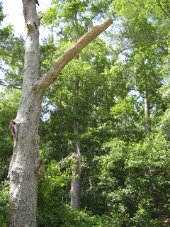I can now see that an area I mulched with woodchips earlier this summer is full of honey fungi (the thick black strands).
Earlier I have lost many young trees due to damage by water rat Arvicola amphibius followed by quick infection by honey fungi. I know use plastic protection on the young trees but I still lose some trees to honey fungi.
For the future I will try to always add spawn of good fungi when mulching. But it would be hard for me to produce enough spawn.
I don`t want to give the honey fungi the energy from the woodchips to cause more mayhem in the garden. How would you go about killing the honey fungi? Soap, bleach, synthetic fertilizer, burning or physically remove the mulch and soil?



